Sergio Escalera
UB
Interact2Ar: Full-Body Human-Human Interaction Generation via Autoregressive Diffusion Models
Dec 22, 2025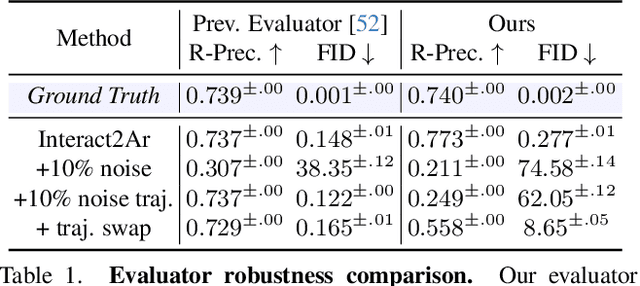
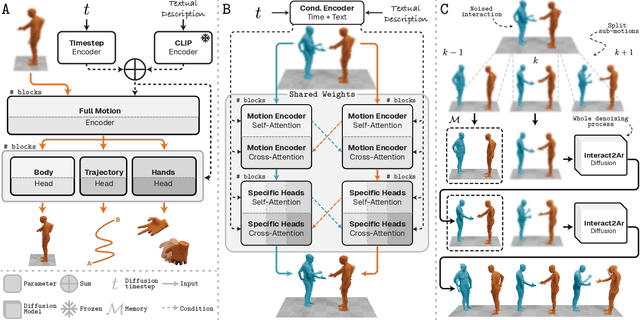
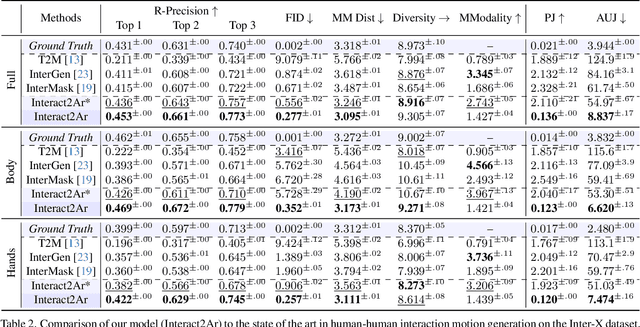
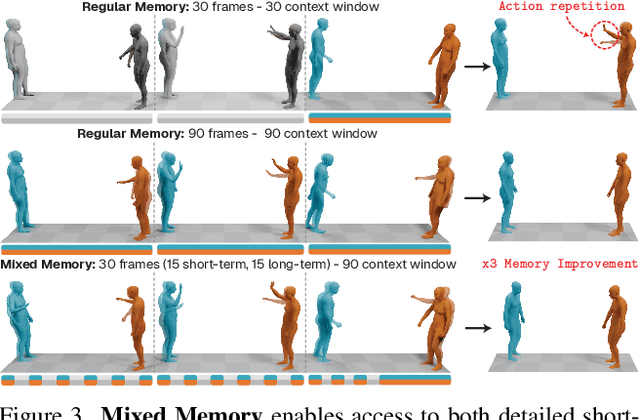
Abstract:Generating realistic human-human interactions is a challenging task that requires not only high-quality individual body and hand motions, but also coherent coordination among all interactants. Due to limitations in available data and increased learning complexity, previous methods tend to ignore hand motions, limiting the realism and expressivity of the interactions. Additionally, current diffusion-based approaches generate entire motion sequences simultaneously, limiting their ability to capture the reactive and adaptive nature of human interactions. To address these limitations, we introduce Interact2Ar, the first end-to-end text-conditioned autoregressive diffusion model for generating full-body, human-human interactions. Interact2Ar incorporates detailed hand kinematics through dedicated parallel branches, enabling high-fidelity full-body generation. Furthermore, we introduce an autoregressive pipeline coupled with a novel memory technique that facilitates adaptation to the inherent variability of human interactions using efficient large context windows. The adaptability of our model enables a series of downstream applications, including temporal motion composition, real-time adaptation to disturbances, and extension beyond dyadic to multi-person scenarios. To validate the generated motions, we introduce a set of robust evaluators and extended metrics designed specifically for assessing full-body interactions. Through quantitative and qualitative experiments, we demonstrate the state-of-the-art performance of Interact2Ar.
RVLF: A Reinforcing Vision-Language Framework for Gloss-Free Sign Language Translation
Dec 08, 2025Abstract:Gloss-free sign language translation (SLT) is hindered by two key challenges: **inadequate sign representation** that fails to capture nuanced visual cues, and **sentence-level semantic misalignment** in current LLM-based methods, which limits translation quality. To address these issues, we propose a three-stage **r**einforcing **v**ision-**l**anguage **f**ramework (**RVLF**). We build a large vision-language model (LVLM) specifically designed for sign language, and then combine it with reinforcement learning (RL) to adaptively enhance translation performance. First, for a sufficient representation of sign language, RVLF introduces an effective semantic representation learning mechanism that fuses skeleton-based motion cues with semantically rich visual features extracted via DINOv2, followed by instruction tuning to obtain a strong SLT-SFT baseline. Then, to improve sentence-level semantic misalignment, we introduce a GRPO-based optimization strategy that fine-tunes the SLT-SFT model with a reward function combining translation fidelity (BLEU) and sentence completeness (ROUGE), yielding the optimized model termed SLT-GRPO. Our conceptually simple framework yields substantial gains under the gloss-free SLT setting without pre-training on any external large-scale sign language datasets, improving BLEU-4 scores by +5.1, +1.11, +1.4, and +1.61 on the CSL-Daily, PHOENIX-2014T, How2Sign, and OpenASL datasets, respectively. To the best of our knowledge, this is the first work to incorporate GRPO into SLT. Extensive experiments and ablation studies validate the effectiveness of GRPO-based optimization in enhancing both translation quality and semantic consistency.
SoccerNet 2025 Challenges Results
Aug 26, 2025Abstract:The SoccerNet 2025 Challenges mark the fifth annual edition of the SoccerNet open benchmarking effort, dedicated to advancing computer vision research in football video understanding. This year's challenges span four vision-based tasks: (1) Team Ball Action Spotting, focused on detecting ball-related actions in football broadcasts and assigning actions to teams; (2) Monocular Depth Estimation, targeting the recovery of scene geometry from single-camera broadcast clips through relative depth estimation for each pixel; (3) Multi-View Foul Recognition, requiring the analysis of multiple synchronized camera views to classify fouls and their severity; and (4) Game State Reconstruction, aimed at localizing and identifying all players from a broadcast video to reconstruct the game state on a 2D top-view of the field. Across all tasks, participants were provided with large-scale annotated datasets, unified evaluation protocols, and strong baselines as starting points. This report presents the results of each challenge, highlights the top-performing solutions, and provides insights into the progress made by the community. The SoccerNet Challenges continue to serve as a driving force for reproducible, open research at the intersection of computer vision, artificial intelligence, and sports. Detailed information about the tasks, challenges, and leaderboards can be found at https://www.soccer-net.org, with baselines and development kits available at https://github.com/SoccerNet.
COOkeD: Ensemble-based OOD detection in the era of zero-shot CLIP
Jul 30, 2025Abstract:Out-of-distribution (OOD) detection is an important building block in trustworthy image recognition systems as unknown classes may arise at test-time. OOD detection methods typically revolve around a single classifier, leading to a split in the research field between the classical supervised setting (e.g. ResNet18 classifier trained on CIFAR100) vs. the zero-shot setting (class names fed as prompts to CLIP). In both cases, an overarching challenge is that the OOD detection performance is implicitly constrained by the classifier's capabilities on in-distribution (ID) data. In this work, we show that given a little open-mindedness from both ends, remarkable OOD detection can be achieved by instead creating a heterogeneous ensemble - COOkeD combines the predictions of a closed-world classifier trained end-to-end on a specific dataset, a zero-shot CLIP classifier, and a linear probe classifier trained on CLIP image features. While bulky at first sight, this approach is modular, post-hoc and leverages the availability of pre-trained VLMs, thus introduces little overhead compared to training a single standard classifier. We evaluate COOkeD on popular CIFAR100 and ImageNet benchmarks, but also consider more challenging, realistic settings ranging from training-time label noise, to test-time covariate shift, to zero-shot shift which has been previously overlooked. Despite its simplicity, COOkeD achieves state-of-the-art performance and greater robustness compared to both classical and CLIP-based OOD detection methods. Code is available at https://github.com/glhr/COOkeD
Sparse-Dense Side-Tuner for efficient Video Temporal Grounding
Jul 10, 2025Abstract:Video Temporal Grounding (VTG) involves Moment Retrieval (MR) and Highlight Detection (HD) based on textual queries. For this, most methods rely solely on final-layer features of frozen large pre-trained backbones, limiting their adaptability to new domains. While full fine-tuning is often impractical, parameter-efficient fine-tuning -- and particularly side-tuning (ST) -- has emerged as an effective alternative. However, prior ST approaches this problem from a frame-level refinement perspective, overlooking the inherent sparse nature of MR. To address this, we propose the Sparse-Dense Side-Tuner (SDST), the first anchor-free ST architecture for VTG. We also introduce the Reference-based Deformable Self-Attention, a novel mechanism that enhances the context modeling of the deformable attention -- a key limitation of existing anchor-free methods. Additionally, we present the first effective integration of InternVideo2 backbone into an ST framework, showing its profound implications in performance. Overall, our method significantly improves existing ST methods, achieving highly competitive or SOTA results on QVHighlights, TACoS, and Charades-STA, while reducing up to a 73% the parameter count w.r.t. the existing SOTA methods. The code is publicly accessible at https://github.com/davidpujol/SDST.
REACT 2025: the Third Multiple Appropriate Facial Reaction Generation Challenge
May 22, 2025

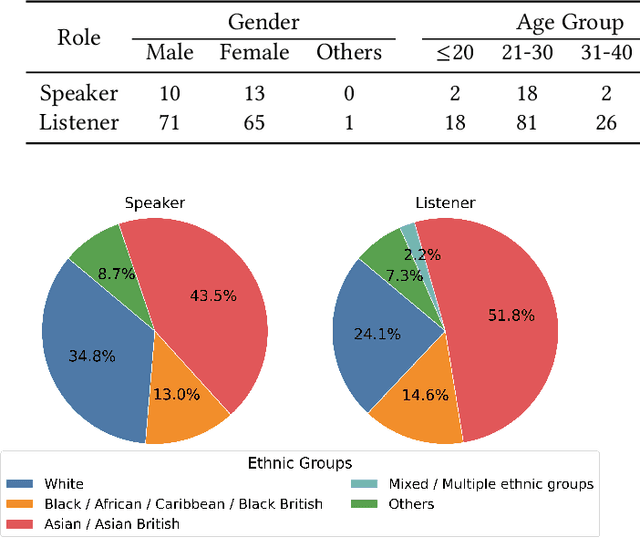
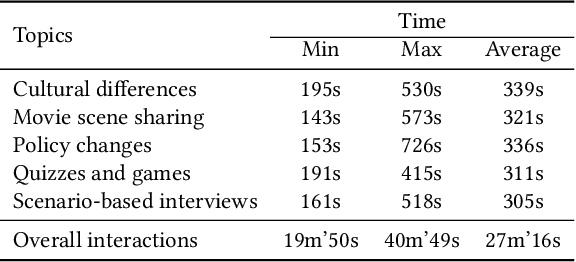
Abstract:In dyadic interactions, a broad spectrum of human facial reactions might be appropriate for responding to each human speaker behaviour. Following the successful organisation of the REACT 2023 and REACT 2024 challenges, we are proposing the REACT 2025 challenge encouraging the development and benchmarking of Machine Learning (ML) models that can be used to generate multiple appropriate, diverse, realistic and synchronised human-style facial reactions expressed by human listeners in response to an input stimulus (i.e., audio-visual behaviours expressed by their corresponding speakers). As a key of the challenge, we provide challenge participants with the first natural and large-scale multi-modal MAFRG dataset (called MARS) recording 137 human-human dyadic interactions containing a total of 2856 interaction sessions covering five different topics. In addition, this paper also presents the challenge guidelines and the performance of our baselines on the two proposed sub-challenges: Offline MAFRG and Online MAFRG, respectively. The challenge baseline code is publicly available at https://github.com/reactmultimodalchallenge/baseline_react2025
L-SWAG: Layer-Sample Wise Activation with Gradients information for Zero-Shot NAS on Vision Transformers
May 12, 2025Abstract:Training-free Neural Architecture Search (NAS) efficiently identifies high-performing neural networks using zero-cost (ZC) proxies. Unlike multi-shot and one-shot NAS approaches, ZC-NAS is both (i) time-efficient, eliminating the need for model training, and (ii) interpretable, with proxy designs often theoretically grounded. Despite rapid developments in the field, current SOTA ZC proxies are typically constrained to well-established convolutional search spaces. With the rise of Large Language Models shaping the future of deep learning, this work extends ZC proxy applicability to Vision Transformers (ViTs). We present a new benchmark using the Autoformer search space evaluated on 6 distinct tasks and propose Layer-Sample Wise Activation with Gradients information (L-SWAG), a novel, generalizable metric that characterizes both convolutional and transformer architectures across 14 tasks. Additionally, previous works highlighted how different proxies contain complementary information, motivating the need for a ML model to identify useful combinations. To further enhance ZC-NAS, we therefore introduce LIBRA-NAS (Low Information gain and Bias Re-Alignment), a method that strategically combines proxies to best represent a specific benchmark. Integrated into the NAS search, LIBRA-NAS outperforms evolution and gradient-based NAS techniques by identifying an architecture with a 17.0% test error on ImageNet1k in just 0.1 GPU days.
Action Anticipation from SoccerNet Football Video Broadcasts
Apr 16, 2025Abstract:Artificial intelligence has revolutionized the way we analyze sports videos, whether to understand the actions of games in long untrimmed videos or to anticipate the player's motion in future frames. Despite these efforts, little attention has been given to anticipating game actions before they occur. In this work, we introduce the task of action anticipation for football broadcast videos, which consists in predicting future actions in unobserved future frames, within a five- or ten-second anticipation window. To benchmark this task, we release a new dataset, namely the SoccerNet Ball Action Anticipation dataset, based on SoccerNet Ball Action Spotting. Additionally, we propose a Football Action ANticipation TRAnsformer (FAANTRA), a baseline method that adapts FUTR, a state-of-the-art action anticipation model, to predict ball-related actions. To evaluate action anticipation, we introduce new metrics, including mAP@$\delta$, which evaluates the temporal precision of predicted future actions, as well as mAP@$\infty$, which evaluates their occurrence within the anticipation window. We also conduct extensive ablation studies to examine the impact of various task settings, input configurations, and model architectures. Experimental results highlight both the feasibility and challenges of action anticipation in football videos, providing valuable insights into the design of predictive models for sports analytics. By forecasting actions before they unfold, our work will enable applications in automated broadcasting, tactical analysis, and player decision-making. Our dataset and code are publicly available at https://github.com/MohamadDalal/FAANTRA.
Action Valuation in Sports: A Survey
Apr 08, 2025Abstract:Action Valuation (AV) has emerged as a key topic in Sports Analytics, offering valuable insights by assigning scores to individual actions based on their contribution to desired outcomes. Despite a few surveys addressing related concepts such as Player Valuation, there is no comprehensive review dedicated to an in-depth analysis of AV across different sports. In this survey, we introduce a taxonomy with nine dimensions related to the AV task, encompassing data, methodological approaches, evaluation techniques, and practical applications. Through this analysis, we aim to identify the essential characteristics of effective AV methods, highlight existing gaps in research, and propose future directions for advancing the field.
From Sparse Signal to Smooth Motion: Real-Time Motion Generation with Rolling Prediction Models
Apr 07, 2025
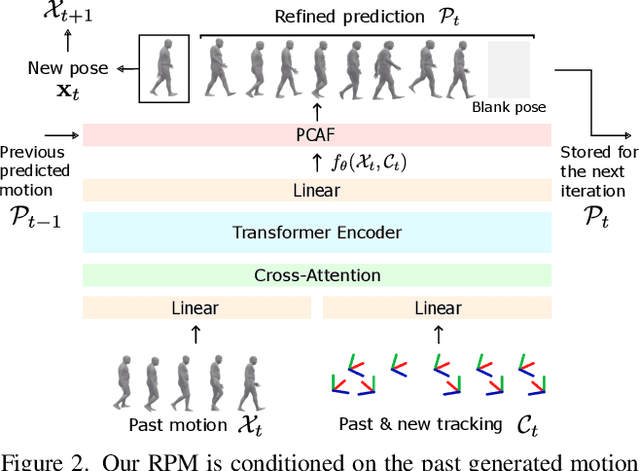

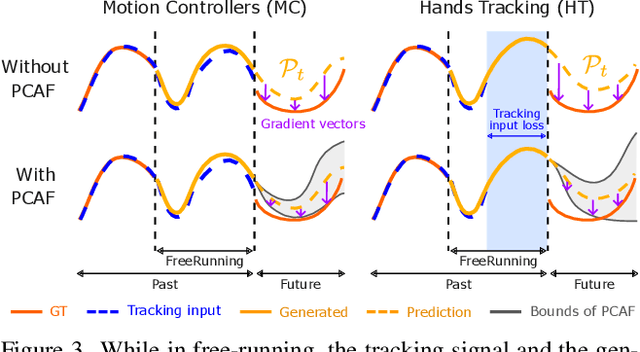
Abstract:In extended reality (XR), generating full-body motion of the users is important to understand their actions, drive their virtual avatars for social interaction, and convey a realistic sense of presence. While prior works focused on spatially sparse and always-on input signals from motion controllers, many XR applications opt for vision-based hand tracking for reduced user friction and better immersion. Compared to controllers, hand tracking signals are less accurate and can even be missing for an extended period of time. To handle such unreliable inputs, we present Rolling Prediction Model (RPM), an online and real-time approach that generates smooth full-body motion from temporally and spatially sparse input signals. Our model generates 1) accurate motion that matches the inputs (i.e., tracking mode) and 2) plausible motion when inputs are missing (i.e., synthesis mode). More importantly, RPM generates seamless transitions from tracking to synthesis, and vice versa. To demonstrate the practical importance of handling noisy and missing inputs, we present GORP, the first dataset of realistic sparse inputs from a commercial virtual reality (VR) headset with paired high quality body motion ground truth. GORP provides >14 hours of VR gameplay data from 28 people using motion controllers (spatially sparse) and hand tracking (spatially and temporally sparse). We benchmark RPM against the state of the art on both synthetic data and GORP to highlight how we can bridge the gap for real-world applications with a realistic dataset and by handling unreliable input signals. Our code, pretrained models, and GORP dataset are available in the project webpage.
 Add to Chrome
Add to Chrome Add to Firefox
Add to Firefox Add to Edge
Add to Edge